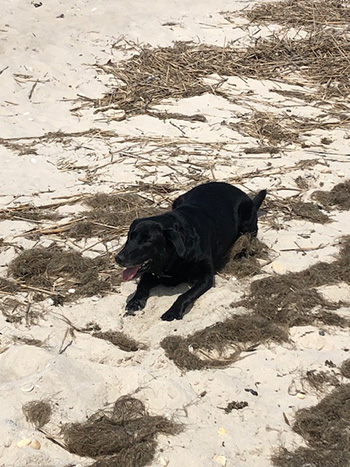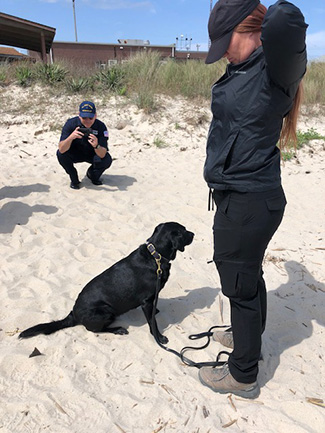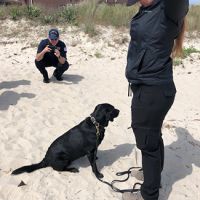USCG Sector Delaware Bay Hosts Oil-Detecting Canine Demonstration
JUNE 20, 2023 — On May 19, 2023, the U.S. Coast Guard Sector Delaware Bay hosted a demonstration of using trained canines to detect subsurface shoreline oiling at Slaughter Beach in Milford, Delaware.

The day started off with an introduction by the owner and Principal of Chiron K9 LLC, a canine consultancy company specializing in detection, based in San Antonio, Texas. The trainer described how a number of studies over the past five years have been completed to demonstrate that specially trained canines can not only detect subsurface oil, but respond to a specific oil down to 18 parts per million (ppm) in laboratory testing. At present, there is no instrument that can measure lesser concentrations than 18 parts per billion (ppb).
The participants learned about an upcoming project, with support from the Bureau of Safety and Environmental Enforcement (BSEE), that is designed to find out if canines can identify component(s) in an oil target or in the field to indicate the presence of oil. This understanding of the odor signature will be a valuable tool for training and validation of oil detection canines and establish science-based credibility for performance and capabilities.
Oil-detecting canines are beneficial because they can be used to identify not only where oil is located, but also where it is not located. According to the trainer, “during the Deepwater Horizon oil spill response, more than 200,000 known pits and trenches were dug with most of them not having any oil in them. Just think of the intensive labor and costs that could have been saved if the canines had been used.” Depending on wind direction, climatic conditions, and amount of oil, dogs can easily detect a source from 30 feet away. The dog will then walk up to the source and change behavior when the source is found.
Texas Tech has been the lead oil detection canine researching institution. Florida International University is also involved with studies involving oil detecting canines. Their work has shown that the typical training for these canines takes approximately 60 to 80 hours.
OR&R supports training and personnel for the Shoreline Cleanup Assessment Technique (SCAT) teams. SCAT is a systematic method for surveying an affected shoreline after an oil spill. The SCAT teams, which include people trained in the techniques, procedures, and terminology of shoreline assessment, are responsible for collecting the data needed to develop a shoreline cleanup plan that maximizes the recovery of oiled habitats and resources, while minimizing the risk of injury. The oil detecting-canines would not replace SCAT teams during a response, rather they would be part of a K9 SCAT team. When a canine locates subsurface oil, the SCAT team would investigate the location where the canine indicated a presence of oil. The canines would normally work a 6-hour day, with a schedule that follows a 50-minute on duty/10-minute rest cycle, however, the cycles would be determined by the environmental conditions.
The cost per trained canine is approximately $200 per hour and there is a minimum 8-hour charge per day. However, costs may vary depending upon unique or hazardous conditions associated with the response and travel and handling costs.
At present, there are five canines that are fully trained worldwide to detect oil on beaches.
For the Slaughter Beach demonstration, 20 oil-filled jars, containing small amounts of oil, were buried about 12 inches below the shoreline’s surface over a distance of 100 yards. During the demonstration, the trained canine was 100 percent successful in finding all 20 buried jars.
more images


